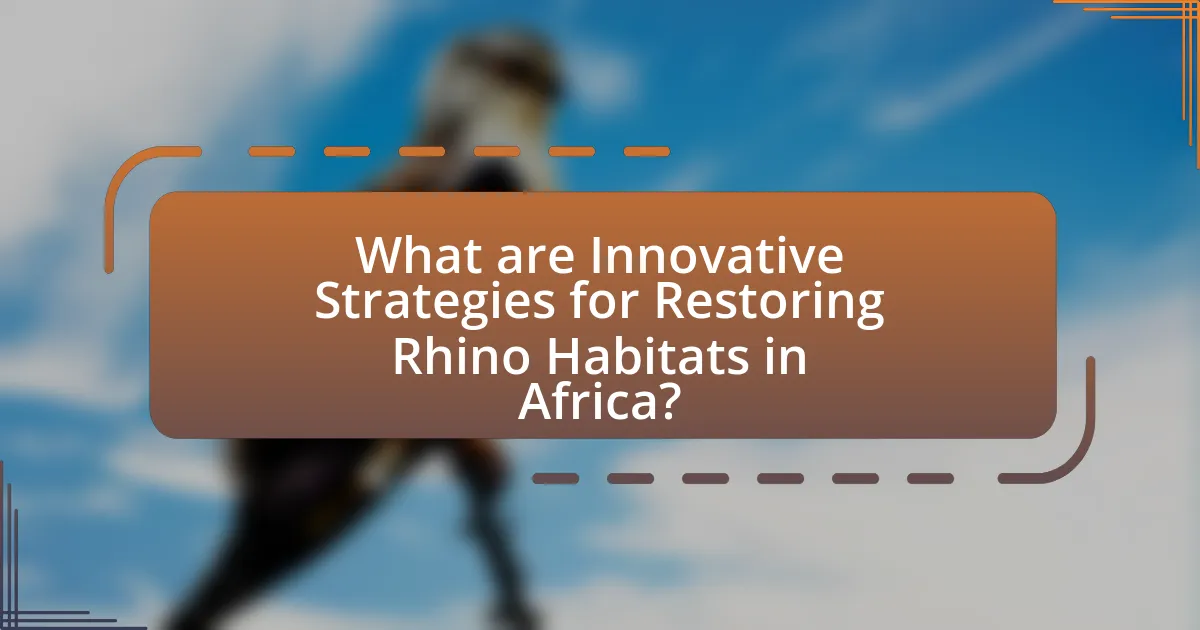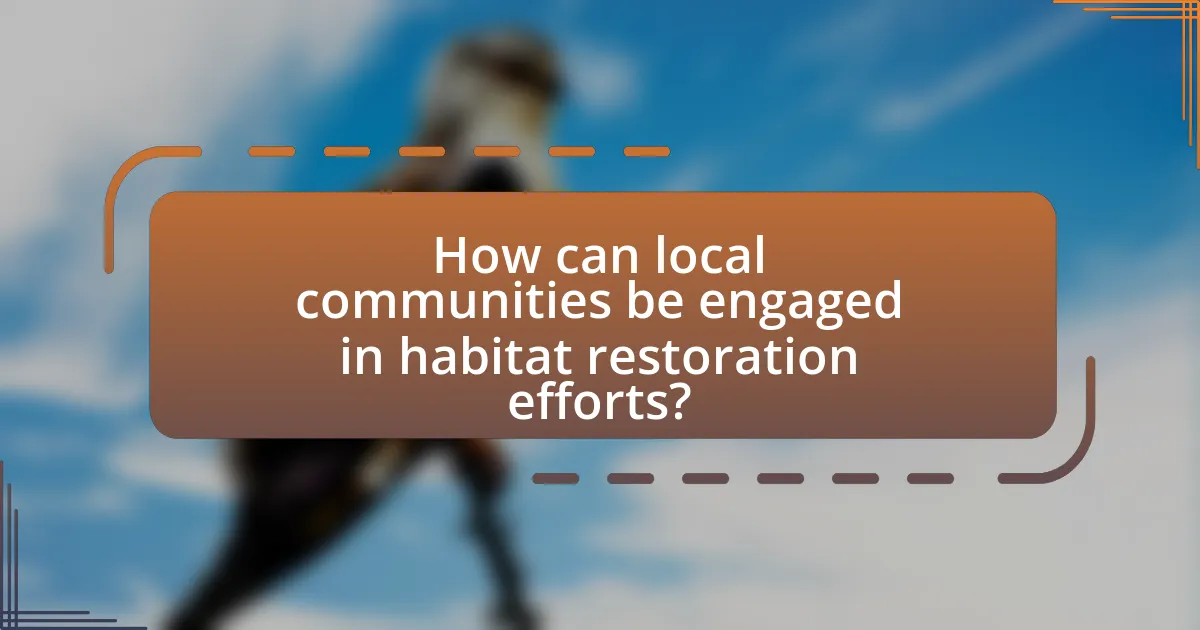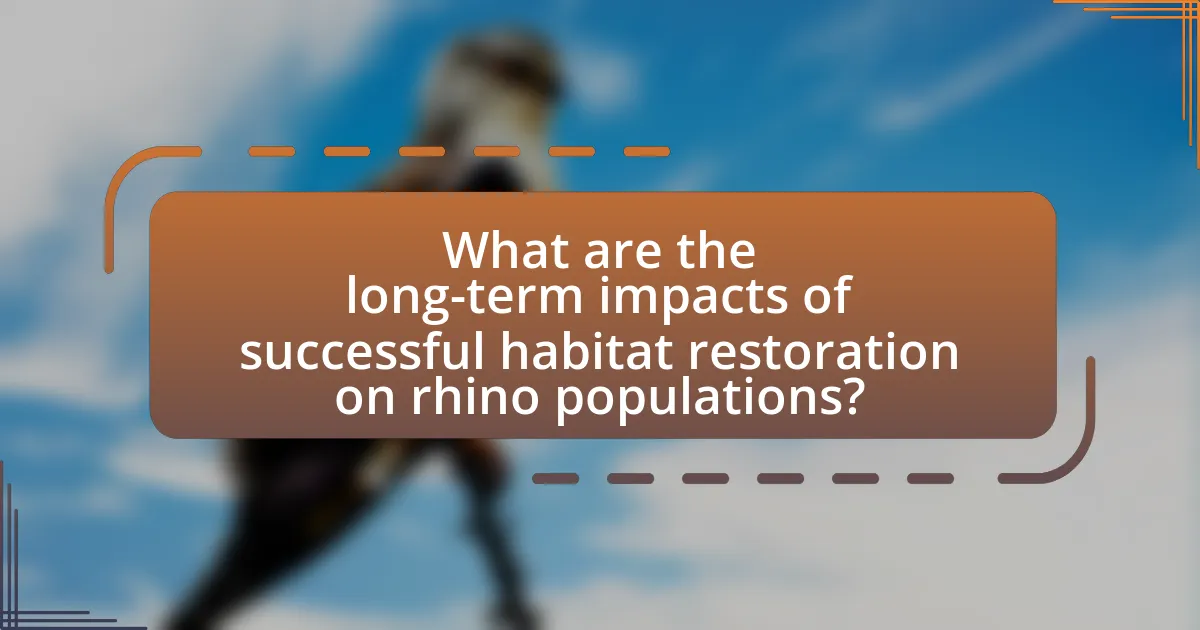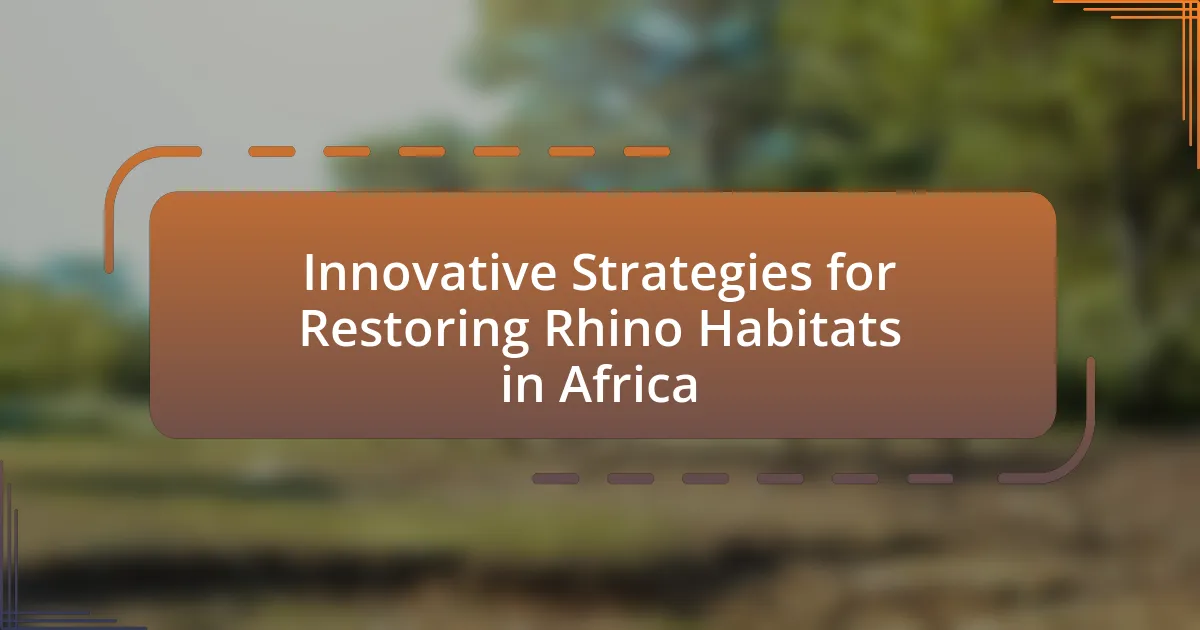The article focuses on innovative strategies for restoring rhino habitats in Africa, highlighting the importance of community-based conservation programs, habitat restoration through reforestation, and the application of technology for monitoring and protection. It discusses the critical role of habitat restoration in addressing the decline of rhino populations due to habitat loss, poaching, and climate change. The article also examines the challenges faced in implementing these strategies, including funding limitations and socio-political barriers, while emphasizing the benefits of engaging local communities and utilizing partnerships between organizations to enhance restoration efforts. Additionally, it outlines best practices for effective habitat restoration and the long-term ecological benefits that arise from successful initiatives.

What are Innovative Strategies for Restoring Rhino Habitats in Africa?
Innovative strategies for restoring rhino habitats in Africa include the implementation of community-based conservation programs, habitat restoration through reforestation, and the use of technology for monitoring and protection. Community-based conservation programs empower local communities to manage and protect rhino habitats, leading to increased biodiversity and sustainable land use. Habitat restoration efforts, such as reforestation, enhance the ecological balance and provide essential resources for rhinos. Additionally, technology, including drones and GPS tracking, allows for real-time monitoring of rhino populations and their habitats, improving anti-poaching efforts and habitat management. These strategies are supported by successful case studies, such as the Black Rhino Range Expansion Project, which has increased rhino populations through habitat restoration and community involvement.
Why is habitat restoration crucial for rhinos in Africa?
Habitat restoration is crucial for rhinos in Africa because it directly addresses the loss of their natural environments, which is a primary factor in their declining populations. Rhinos depend on specific habitats for food, water, and breeding, and the degradation of these areas due to human activities, such as agriculture and urban development, has led to significant habitat fragmentation. According to the International Union for Conservation of Nature, habitat loss is one of the leading threats to rhino survival, with some species experiencing population declines of over 90% in the last century. Restoring these habitats not only provides rhinos with the necessary resources for survival but also enhances biodiversity and ecosystem health, creating a more sustainable environment for both wildlife and local communities.
What are the current threats to rhino habitats?
Current threats to rhino habitats include habitat loss, poaching, and climate change. Habitat loss primarily results from agricultural expansion and urban development, which reduce the land available for rhinos. Poaching for rhino horns, driven by illegal wildlife trade, significantly decreases rhino populations and disrupts their natural habitats. Climate change exacerbates these threats by altering ecosystems, affecting food and water availability, and increasing the frequency of extreme weather events. According to the International Union for Conservation of Nature, habitat loss and poaching are among the top reasons for the decline of rhino populations globally, highlighting the urgent need for conservation efforts.
How does habitat loss impact rhino populations?
Habitat loss significantly reduces rhino populations by diminishing their living space and food resources. As natural habitats are converted for agriculture, urban development, or other human activities, rhinos face increased competition for limited resources, leading to malnutrition and decreased reproductive success. According to the International Union for Conservation of Nature (IUCN), habitat loss is one of the primary threats to rhinos, contributing to a decline in their numbers by over 90% in some regions over the past century. This loss of habitat not only affects individual rhinos but also disrupts social structures and breeding patterns, further endangering their survival.
What innovative strategies are being implemented for habitat restoration?
Innovative strategies for habitat restoration include the use of advanced technology such as drones for monitoring and mapping ecosystems, as well as the implementation of ecological engineering techniques to restore native vegetation. These methods enhance biodiversity and improve the resilience of habitats. For instance, the African Wildlife Foundation has utilized drones to survey and assess rhino habitats, allowing for precise data collection that informs restoration efforts. Additionally, the integration of community-based conservation practices empowers local populations to participate actively in habitat restoration, ensuring sustainable management of resources.
How do community-based conservation efforts contribute to habitat restoration?
Community-based conservation efforts significantly contribute to habitat restoration by engaging local populations in sustainable practices that protect and rehabilitate ecosystems. These initiatives empower communities to manage natural resources, leading to improved biodiversity and ecosystem health. For instance, a study published in the journal “Conservation Biology” found that areas where local communities actively participated in conservation saw a 30% increase in native plant species and a corresponding rise in wildlife populations. This collaborative approach fosters stewardship, ensuring that restoration efforts are culturally relevant and economically beneficial, thus enhancing long-term sustainability.
What role does technology play in restoring rhino habitats?
Technology plays a crucial role in restoring rhino habitats by enabling precise monitoring and management of ecosystems. Advanced tools such as satellite imagery and drones facilitate the assessment of habitat conditions, allowing conservationists to identify areas in need of restoration. For instance, the use of Geographic Information Systems (GIS) helps in mapping vegetation and water sources critical for rhinos, ensuring that restoration efforts are targeted effectively. Additionally, technology aids in anti-poaching efforts through real-time tracking systems, which protect rhinos and their habitats from illegal activities. Studies have shown that integrating technology in conservation strategies significantly enhances the success rates of habitat restoration projects, thereby supporting the overall survival of rhino populations.
What are the challenges faced in implementing these strategies?
The challenges faced in implementing innovative strategies for restoring rhino habitats in Africa include funding limitations, political instability, and community resistance. Funding limitations hinder the ability to execute large-scale restoration projects, as significant financial resources are required for land acquisition, habitat management, and ongoing monitoring. Political instability can disrupt conservation efforts, as changes in government priorities or policies may lead to inconsistent support for habitat restoration initiatives. Community resistance arises when local populations perceive conservation strategies as threats to their livelihoods, leading to conflicts between conservation goals and local economic needs. These challenges are documented in various studies, including the “State of African Rhino Conservation” report by the International Rhino Foundation, which highlights the need for sustainable funding and community engagement to overcome these barriers.
How do funding and resource allocation affect restoration efforts?
Funding and resource allocation significantly impact restoration efforts by determining the scale, effectiveness, and sustainability of projects aimed at rehabilitating ecosystems. Adequate funding allows for the implementation of comprehensive strategies, including habitat restoration, anti-poaching measures, and community engagement initiatives, which are essential for the recovery of rhino populations in Africa. For instance, a study by the World Wildlife Fund indicated that projects with robust financial backing are more likely to achieve long-term ecological goals, as they can afford necessary resources such as skilled personnel, technology, and ongoing monitoring. Conversely, insufficient funding often leads to fragmented efforts, limiting the scope of restoration activities and reducing their overall success rate.
What are the socio-political barriers to effective habitat restoration?
Socio-political barriers to effective habitat restoration include inadequate policy frameworks, lack of funding, and conflicting land-use priorities. In many regions, policies do not prioritize ecological restoration, leading to insufficient legal support for habitat initiatives. Additionally, funding for restoration projects is often limited, as governments and organizations may allocate resources to immediate economic needs rather than long-term ecological benefits. Conflicting land-use priorities arise when agricultural, industrial, or urban development interests take precedence over conservation efforts, resulting in habitat degradation. For instance, in Africa, land tenure issues complicate restoration efforts, as local communities may not have secure rights to land, making them less likely to engage in or support restoration initiatives.

How can local communities be engaged in habitat restoration efforts?
Local communities can be engaged in habitat restoration efforts by involving them in decision-making processes and providing education on the ecological importance of their local environments. This engagement fosters a sense of ownership and responsibility towards habitat restoration. For instance, programs like community-based natural resource management in Africa have shown that when local people are included in conservation strategies, they are more likely to participate actively in restoration activities. Research indicates that communities that are educated about the benefits of biodiversity and habitat health are more inclined to support and engage in restoration initiatives, leading to improved outcomes for ecosystems and species such as rhinos.
What benefits do local communities gain from participating in restoration projects?
Local communities gain multiple benefits from participating in restoration projects, including economic opportunities, enhanced environmental stewardship, and improved social cohesion. Economic opportunities arise through job creation in restoration activities, which can lead to increased income and local business growth. For instance, a study by the World Resources Institute found that community-based conservation initiatives can generate up to 50% more income for local households compared to traditional land use practices. Enhanced environmental stewardship occurs as community members develop a vested interest in the health of their ecosystems, leading to sustainable practices that benefit both wildlife and local livelihoods. Improved social cohesion is fostered through collaborative efforts, as community members work together towards common goals, strengthening relationships and community identity.
How can education and awareness programs enhance community involvement?
Education and awareness programs enhance community involvement by providing knowledge and fostering a sense of responsibility towards local environmental issues, particularly in the context of rhino habitat restoration. These programs equip community members with information about the ecological importance of rhinos and the threats they face, which can lead to increased participation in conservation efforts. For instance, a study by the World Wildlife Fund found that communities engaged in educational initiatives were 40% more likely to participate in habitat restoration activities compared to those without such programs. This demonstrates that informed communities are more proactive in protecting their natural resources and supporting conservation initiatives.
What incentives can be provided to encourage local participation?
Financial incentives, such as direct payments or subsidies for conservation efforts, can effectively encourage local participation in restoring rhino habitats. These financial rewards motivate communities to engage in sustainable practices that protect wildlife and their ecosystems. For instance, programs like the Payment for Ecosystem Services (PES) have shown success in various regions by compensating local landowners for maintaining habitats that support biodiversity, including rhinos. Additionally, providing training and resources for eco-tourism initiatives can create alternative income streams, further incentivizing local involvement in conservation efforts.
How can partnerships between organizations enhance restoration efforts?
Partnerships between organizations can enhance restoration efforts by pooling resources, expertise, and networks to achieve common conservation goals. Collaborative initiatives, such as those seen in the African rhino restoration projects, allow organizations to share best practices, leverage funding, and coordinate on-the-ground activities more effectively. For instance, the collaboration between the World Wildlife Fund and local conservation groups has led to increased anti-poaching measures and habitat restoration, resulting in a measurable increase in rhino populations in certain regions. This synergy not only amplifies the impact of individual efforts but also fosters a holistic approach to ecosystem management, ultimately leading to more sustainable restoration outcomes.
What types of organizations are most effective in these partnerships?
Conservation organizations, governmental agencies, and local communities are the most effective types of organizations in partnerships focused on restoring rhino habitats in Africa. Conservation organizations bring expertise in wildlife management and habitat restoration, while governmental agencies provide regulatory support and funding. Local communities contribute traditional knowledge and stewardship of the land, which is crucial for sustainable practices. For instance, successful partnerships like the African Rhino Conservation Programme demonstrate how these entities can collaborate effectively, leading to increased rhino populations and improved habitat conditions.
How can knowledge sharing improve restoration strategies?
Knowledge sharing can significantly enhance restoration strategies by facilitating the exchange of best practices, data, and experiences among stakeholders involved in habitat restoration. This collaborative approach allows for the integration of diverse perspectives and expertise, leading to more effective and adaptive management techniques. For instance, research conducted by the World Wildlife Fund highlights that sharing successful case studies from various regions can inform local strategies, thereby increasing the likelihood of successful restoration outcomes. Furthermore, knowledge sharing fosters innovation by encouraging the development of new methodologies tailored to specific ecological contexts, ultimately improving the resilience of rhino habitats in Africa.

What are the long-term impacts of successful habitat restoration on rhino populations?
Successful habitat restoration significantly enhances rhino populations by improving their survival rates and reproductive success. Restored habitats provide essential resources such as food, water, and shelter, which are critical for the health and growth of rhino populations. For instance, studies have shown that in areas where habitat restoration efforts have been implemented, rhino populations can increase by up to 30% over a decade due to reduced competition for resources and improved ecosystem health. Additionally, restored habitats can lead to greater genetic diversity among rhinos, as they can expand their range and access new breeding opportunities, further bolstering population resilience.
How does habitat restoration influence rhino breeding and survival rates?
Habitat restoration significantly enhances rhino breeding and survival rates by improving the availability of food, water, and shelter. When habitats are restored, rhinos benefit from increased vegetation cover, which provides essential forage and reduces competition for resources. For instance, studies have shown that in areas where habitat restoration efforts have been implemented, such as the restoration of grasslands and wetlands, rhino populations have experienced a notable increase in reproductive success and overall population growth. Specifically, the African rhino population in restored areas has seen a rise in birth rates, with some regions reporting increases of up to 30% in calf survival rates due to improved habitat conditions. This evidence underscores the critical role of habitat restoration in supporting the ecological needs of rhinos, ultimately leading to enhanced breeding success and higher survival rates.
What ecological benefits arise from restoring rhino habitats?
Restoring rhino habitats provides significant ecological benefits, including enhanced biodiversity, improved ecosystem health, and increased carbon sequestration. The presence of rhinos supports a variety of plant and animal species, as they help maintain the structure of grasslands and forests through their grazing and browsing activities. This interaction promotes a diverse range of flora and fauna, which is crucial for ecosystem resilience. Additionally, healthy rhino habitats contribute to soil stabilization and water retention, which are vital for preventing erosion and maintaining local water cycles. Studies have shown that areas with restored rhino populations often see a resurgence in other wildlife, indicating a positive ripple effect on overall biodiversity.
How can restored habitats contribute to biodiversity conservation?
Restored habitats significantly contribute to biodiversity conservation by providing essential ecosystems for various species to thrive. These habitats enhance species richness and abundance by re-establishing native flora and fauna, which are crucial for maintaining ecological balance. For instance, studies have shown that restored wetlands can support up to 50% more bird species compared to degraded areas, demonstrating the positive impact of habitat restoration on avian diversity. Furthermore, restored habitats can serve as corridors for wildlife movement, facilitating gene flow and reducing the risks of inbreeding among isolated populations. This is particularly important for endangered species, such as rhinos, as it helps maintain their genetic diversity and resilience against environmental changes.
What best practices should be followed for effective habitat restoration?
Effective habitat restoration requires a multi-faceted approach that includes assessing ecological conditions, engaging local communities, and implementing adaptive management strategies. Assessing ecological conditions involves evaluating the current state of the habitat, identifying key species, and understanding the historical context of the ecosystem. Engaging local communities ensures that restoration efforts align with the needs and knowledge of those who live in the area, fostering stewardship and support for the project. Implementing adaptive management strategies allows for ongoing monitoring and adjustments based on the success of restoration efforts, ensuring that practices remain effective over time. These best practices are supported by studies indicating that community involvement and adaptive management significantly enhance the success rates of restoration projects, particularly in complex ecosystems like those inhabited by rhinos in Africa.
How can monitoring and evaluation improve restoration outcomes?
Monitoring and evaluation can significantly improve restoration outcomes by providing data-driven insights that inform adaptive management strategies. By systematically tracking ecological indicators, such as vegetation recovery and wildlife population dynamics, stakeholders can assess the effectiveness of restoration interventions. For instance, a study published in the journal “Ecological Applications” demonstrated that projects incorporating regular monitoring were 30% more likely to achieve their ecological goals compared to those without such practices. This evidence underscores the importance of continuous feedback loops, allowing for timely adjustments to restoration techniques based on observed results, ultimately leading to more successful habitat recovery for rhinos in Africa.
What lessons have been learned from past restoration projects?
Past restoration projects have demonstrated the importance of community involvement and adaptive management in achieving successful outcomes. Engaging local communities fosters stewardship and ensures that restoration efforts align with the needs and values of those directly affected. For instance, projects in South Africa have shown that when communities are actively involved, poaching rates decrease, and habitat restoration efforts are more sustainable. Additionally, adaptive management, which involves monitoring and adjusting strategies based on ongoing results, has proven essential in addressing unforeseen challenges and optimizing restoration techniques. This approach has been validated by various studies, including the “Restoration Ecology” journal, which highlights the effectiveness of flexible strategies in ecological restoration.
